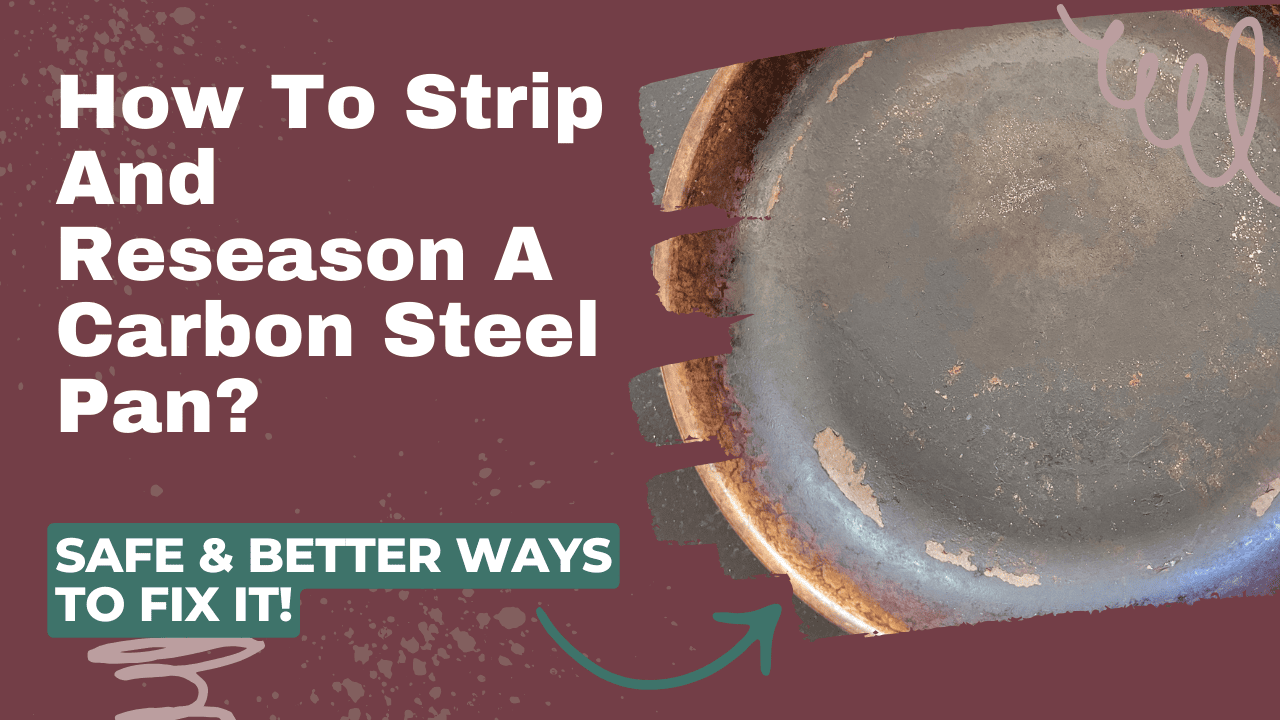Seasoning is part of the everyday life of a carbon steel skillet. Layers of seasoning build naturally as you cook with the pan, and there will be times when you need to give a dry-looking pan a boost with a dedicated seasoning session.
But totally stripping a carbon steel pan – that is, taking it down to the bare metal, or as some call it, “nuking” a pan – is rarely necessary. Problems like flaking seasoning, carbon buildup, and gummy spots can all be fixed without obliterating the layers of blackened polymerized oil that have bonded to your pan. Because, let me tell you, that stuff is tough to get off.
As I’ve worked more with carbon steel in my kitchen, I’ve learned a ton about restoring seasoning on these pans. Let’s talk about how to strip and re-season a carbon steel pan, when you should do it, and how you can fix uneven seasoning in less drastic ways.
How To Strip and Reseason a Carbon Steel Pan?
The simplest way to strip and re-season a carbon steel pan is to:
- Scrub the pan to remove carbon buildup.
- Fill the pan with 50% vinegar and water solution.
- Boil for 20 minutes.
- Leave it to cool and sit for a number of hours.
- Scrub off the seasoning with steel wool.
- Rub a bit of oil on the pan and heat to season it.
This method only removes seasoning from the inside of the pan. There are several other methods that will remove buildup from the outside of the pan as well.
I’ll go into details on all of these in a bit.
When Do You Need to “Nuke” or Strip Your Carbon Steel Pan?
The three main reasons why you may choose to strip a carbon steel pan include severe rust, excessive carbon buildup, or a flaking first layer of seasoning.
Reason #1: Rust
Rust can happen on any carbon steel pan if the seasoning wears thin. You can easily remove small spots of rust by scrubbing them with oil and salt. But if you’re restoring an old carbon steel pan that has been neglected and rusting for a long time, the rust may have eaten away enough of the iron that you’ll decide to start from scratch.
Reason #2: Excessive Carbon Buildup
Once I tried to caramelize sugar in a carbon steel pan. Instead, I ended up bonding the sugar to my seasoning, leaving black grit in the bottom of the pan. I was able to remove about half of it by boiling water and another bit by scrubbing. But by that point, I had done such a number on the seasoning that I decided to start over on it.
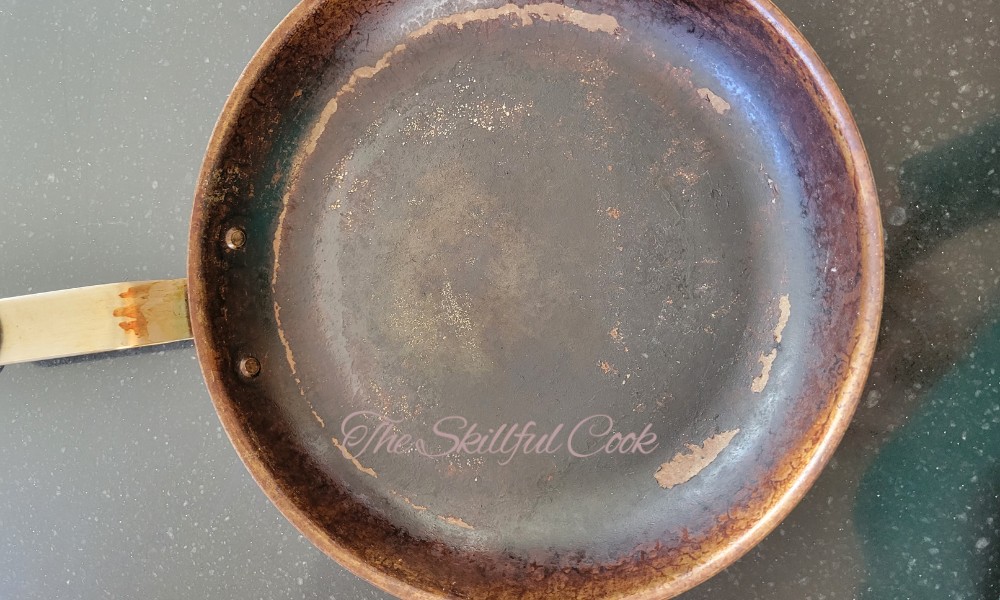
Reason #3: Poor Initial Seasoning
Flaking seasoning does not automatically mean that you need to strip the pan. But some oils produce brittle coats of seasoning (I’m looking at you, flaxseed oil) that are more prone to flaking. If the first layer of seasoning on your pan is brittle and flaking, you may want to strip it and try again with a different oil.
That’s what was happening to my friend’s Misen pan that I decided to strip and re-season. The initial layer of seasoning was flaking, and it had a lot of carbon buildup, so I offered to clean it up for her. The photos you see in this tutorial are from stripping and reseasoning her Misen fry pan.
What You Will Need to Strip and Re-Season Carbon Steel
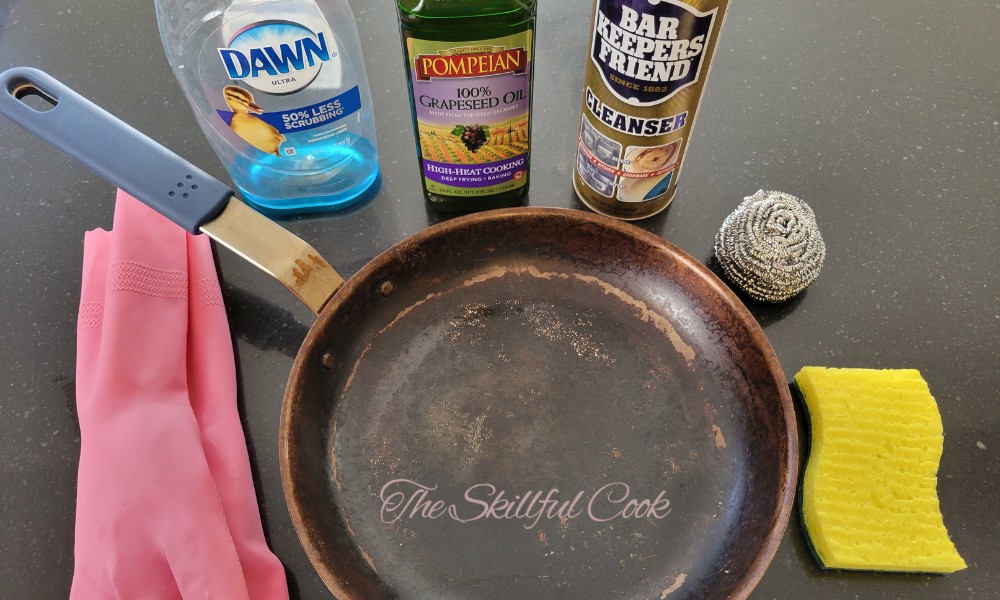
How to Strip and Re-Season a Carbon Steel Pan Step-By-Step
1. Clean the Pan
In this step, you’ll evaluate whether your pan needs to be stripped or whether a good scrubbing will take care of it. Mix some coarse salt with oil and scrub away at rust spots or carbon buildup until you can’t remove any more. Warming the pan slightly may help loosen burnt food.
Are layers of seasoning flaking off the pan? Are there patches of rough, blackened bits that you can’t get off? Try boiling water in the pan; will the carbonized food still not let go? In that case, you may want to strip your pan.
If you got the rust or crud off and the seasoning isn’t flaking down to the bare metal, you can skip to step 5 and season the pan again without stripping it.
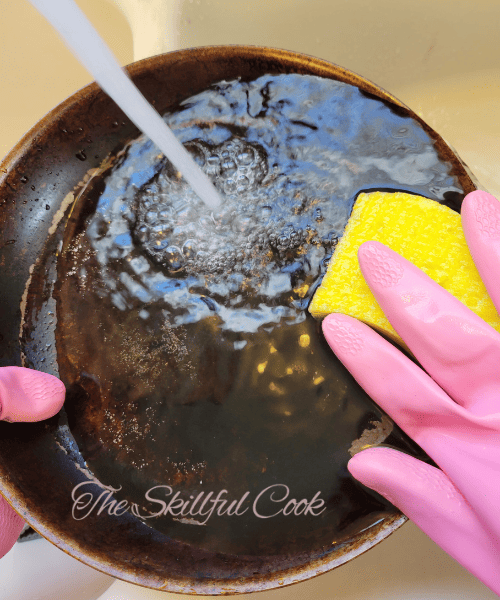
2. Soak in Vinegar
The best way to remove seasoning from a pan is to soak it in an acid solution. You can do this at home with a 50/50 vinegar and water mix. Fill a basin or sink with water and vinegar and place the pan into it. Or, if you only want to strip the inside of the pan but not the outside, you can set the pan on the stove and fill it with the solution.
If your pan is on the stove, bring it to a boil and let it simmer for 10 minutes. The heat will accelerate the process. Do not dump out the water after that; let it sit.
3. Wait
Let the pan sit in the vinegar solution for 4-8 hours. You can take a wooden spatula and scrape the seasoning every few hours to check its progress, but the longer you let the pan sit, the more thoroughly the acid will remove the polymerized oil. I like to leave the pan in the solution overnight.
4. Scrub the Seasoning Off
When the pan has been in the solution long enough, the seasoning should scrape off easily. Wash the pan with a scour to scrub off the layers of blackened oil. Be thorough; any spots of seasoning left on the surface will make it uneven and trap food. Don’t be afraid to use soap.
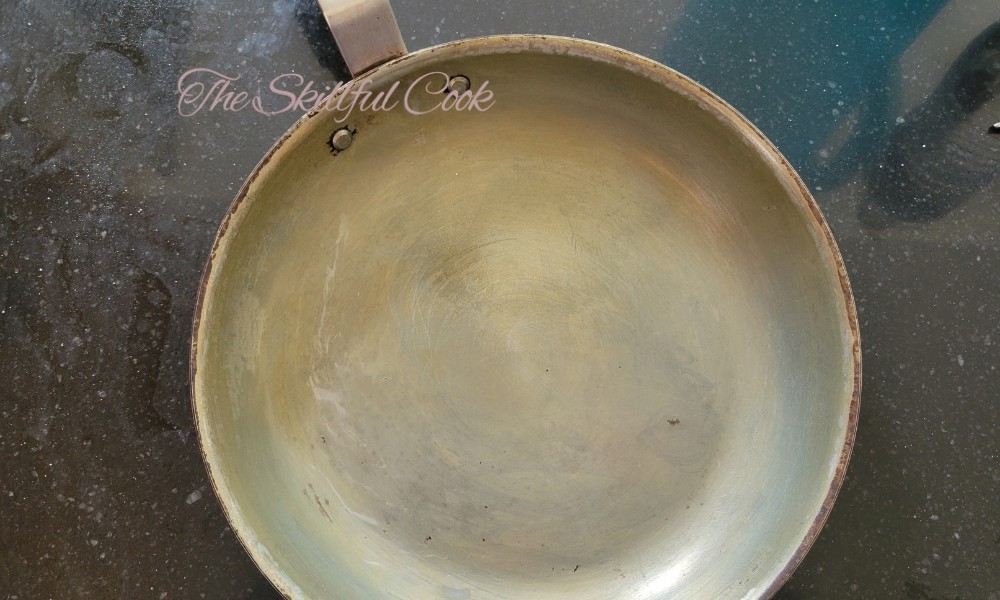
5. Dry and Season the Pan
Once the pan is clean and stripped to the bare metal, dry and season it to prevent rust. Place it on the stovetop with the heat on as low as it will go. Let the heat dry off the pan. Remove the pan from the heat. While it is still warm (but not hot), rub a drop or two (not more!) of neutral oil all over the pan. Aggressively wipe off any excess oil. Then heat the pan on the stovetop for several minutes until the pan changes to a darker color and the pan stops smoking.
See our complete guide to seasoning a carbon steel pan for a more detailed tutorial.
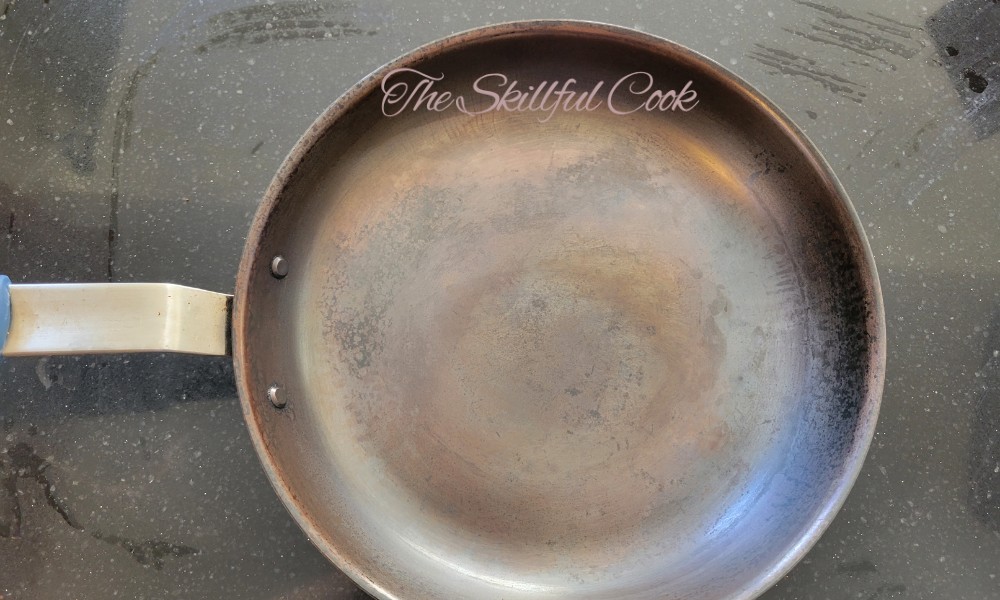
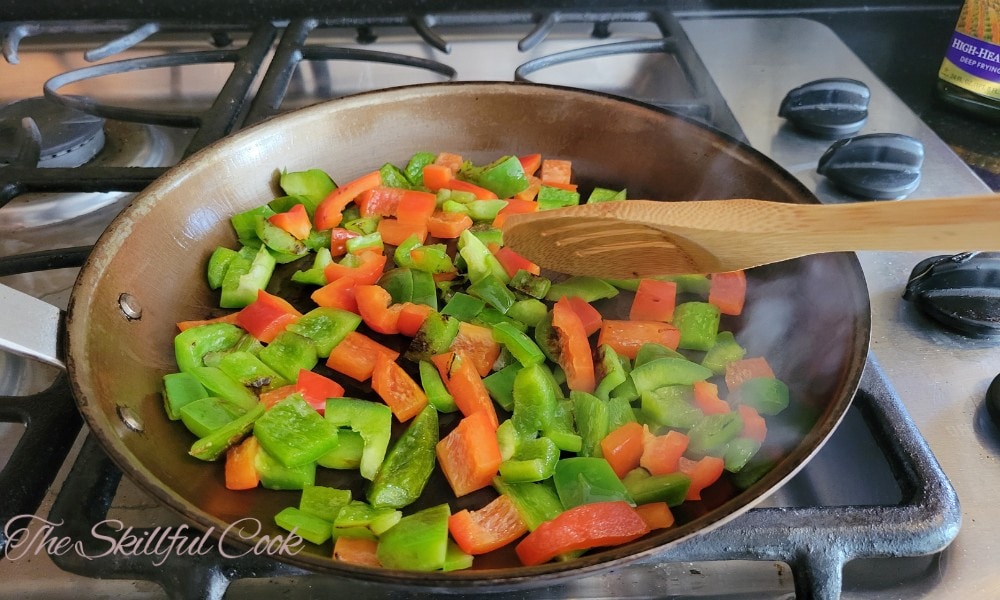
Alternate Methods
Although the vinegar method is effective at removing seasoning, it takes a while – sometimes overnight.
There are other methods of removing seasoning – but none of them are shortcuts. Those layers of polymerized oil are literally bonded to the metal of your pan and are really, really hard to get off – so don’t jump into a full reseasoning project if you need the pan for dinner that night!
If you search the web, you’ll find several other ideas for stripping the seasoning off carbon steel pans – some of them less safe than others. They include:
But, as you can see from my photos, the vinegar method is not only simple and relatively safe, but it works perfectly well.
And, as I said, a lot of time you don’t need to strip the pan entirely to fix rough spots in the seasoning!
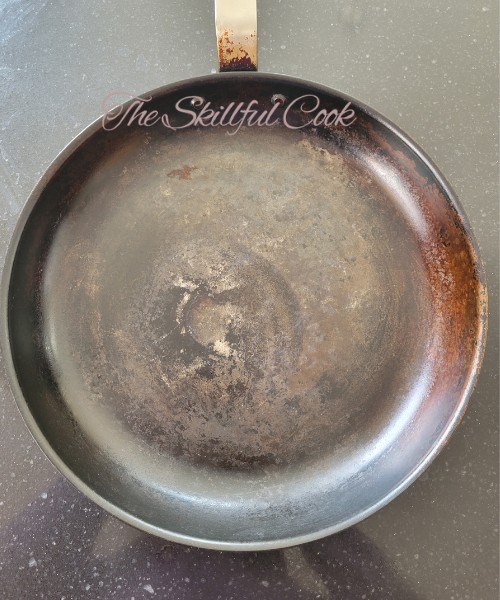
How Do You Fix Sticky Spots on a Carbon Steel Pan?
Reddish-brown gummy spots on a carbon steel pan are from oil that hasn’t fully polymerized. To fix them, scrub with a tough scour and a mixture of oil and salt or baking soda and water. To prevent sticky spots from happening in the future, reduce the amount of oil you use when seasoning to an invisibly thin layer.
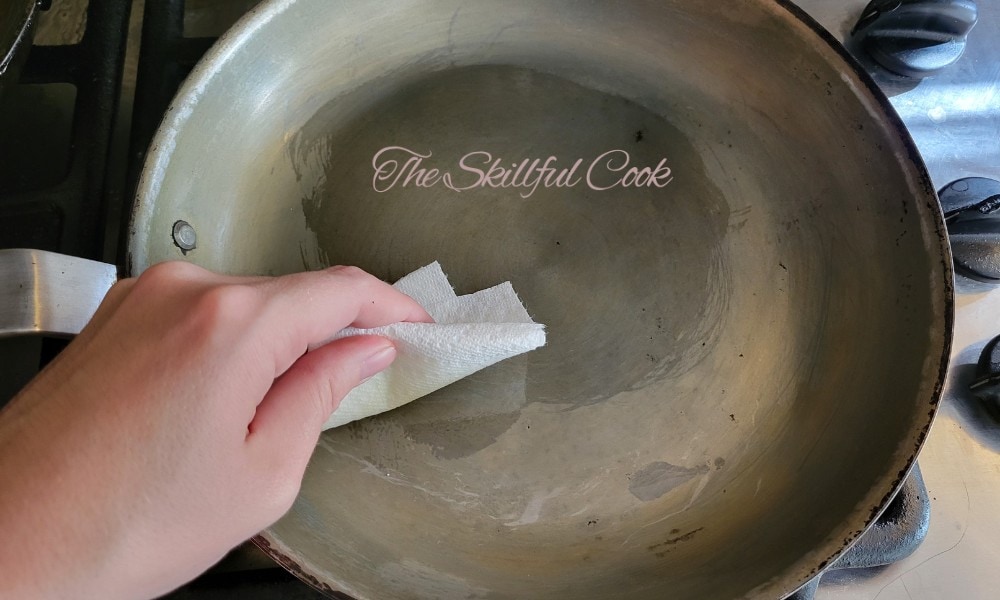
When you season a carbon steel pan, you wipe it down with oil and then burn the oil off. But if your pan looks glossy after applying oil, you used too much! Continue to wipe down the pan with a dry paper towel until you can barely tell that there’s any oil at all. This will prevent sticky spots and greatly reduce the amount of smoke produced when seasoning.
If your pan is just a little sticky after seasoning, you can try continuing to heat it to get the last bit of oil to fully polymerize.
And here’s one more super important tip: If you dry your pan on the stove after washing it, let it cool before applying oil to it afterward. Drying the pan on a warm stove and applying a layer of oil afterward is great – it protects your pan from moisture and rust. But if you spread oil on the pan while it is still hot, the oil may dry and get gummy – but it won’t heat up enough to polymerize and add to the seasoning. (I made this mistake for way too long!)
What If the Seasoning is Flaking?
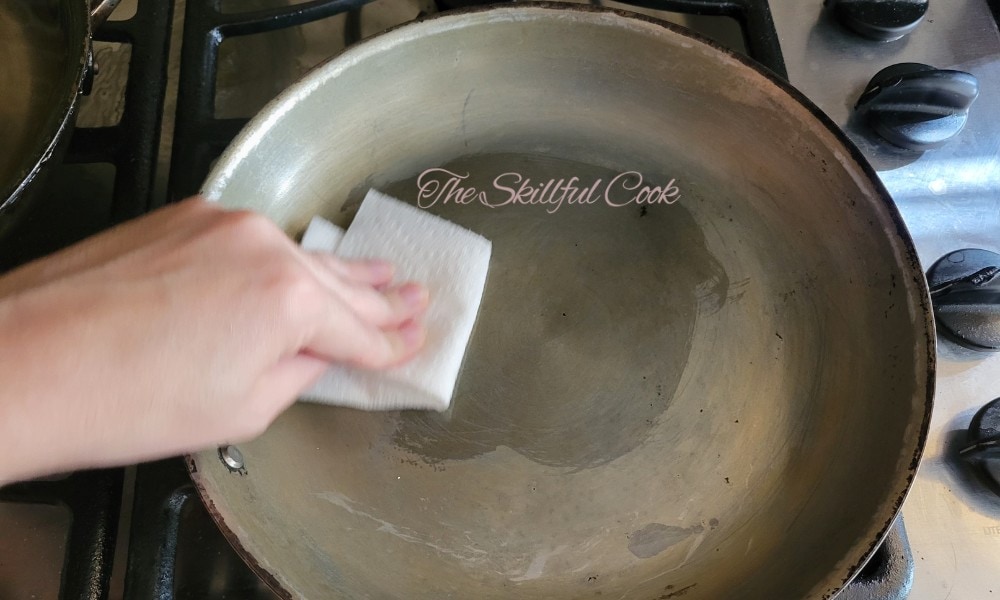
If the seasoning is flaking off your carbon steel pan, give it a really good scrub with salt and oil or with cast iron soap and a moderately abrasive pad. This should remove all carbon buildup and any seasoning that is weak or compromised and likely to flake off. At this point you can decide whether to strip the pan fully or patch the bare spots with new seasoning. In most cases, if you season the pan as normal a few times, you can restore an even surface.
In Sum
I don’t think this has ever been studied, but in my experience, the seasoning on carbon steel can be a bit more delicate than on cast iron. It’s more likely to flake, and you may be tempted to start from scratch on your pan. Try a thorough cleaning and seasoning first, and if that doesn’t work, stripping and re-seasoning carbon steel can be really satisfying.
Have you ever had to strip a carbon steel pan? What brands do you find more likely to flake than others? I’d love to hear if your experience is the same as mine, so let me know in the comments!

